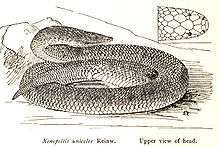Xenopeltidae
| Xenopeltidae | |
|---|---|
 | |
| Sunbeam snake, X. unicolor | |
| Scientific classification | |
| Kingdom: | Animalia |
| Phylum: | Chordata |
| Subphylum: | Vertebrata |
| Class: | Reptilia |
| Order: | Squamata |
| Suborder: | Serpentes |
| Infraorder: | Alethinophidia |
| Family: | Xenopeltidae Bonaparte, 1845 |
| Genus: | Xenopeltis Reinwardt, 1827 |
| Synonyms | |
|
Family:
Genus: | |
- Common names: sunbeam snakes.[2]
The Xenopeltidae are a monotypic family of snakes created for the genus Xenopeltis, which is found in Southeast Asia. Its members are known for their highly iridescent scales. Currently, two species are recognized and no subspecies.[3] Studies of DNA suggest that the xenopeltids are most closely related to the Mexican burrowing python (Loxocemus) and pythons.
Description
Adults can grow up to 1.3 m (51 in) in length.[4] The head scales are made up of large plates much like those of the Colubridae, while the ventral scales are only slightly reduced. Pelvic vestiges are not present.[5]
The dorsal color pattern is a reddish-brown, brown, or blackish color. The belly is an unpatterned whitish-gray.[6] The scales are highly iridescent, creating a beautiful display of colors in the light.[5]
Geographic range
They are found in Southeast Asia from the Andaman and Nicobar Islands, east through Myanmar to southern China, Thailand, Laos, Cambodia, Vietnam, the Malay Peninsula and the East Indies to Sulawesi, as well as the Philippines.[1]
Behavior and diet
These snakes are fossorial, spending much of their time hidden. They emerge at dusk to actively forage for frogs, other snakes, and small mammals. They are not venomous, and kill their prey with constriction.[6]
Species
| Species[3] | Taxon author[3] | Common name | Geographic range[1] |
|---|---|---|---|
| X. hainanensis | Hu & Zhao, 1972 | China: from Zhejiang west to Guangxi and south to Hainan Island. | |
| X. unicolorT | Reinwardt, 1827 | Sunbeam snake[7] | Myanmar (Tenasserim), the Andaman and Nicobar Islands, southern China (Guangdong and Yunnan), Thailand, Laos, Cambodia, Vietnam, West Malaysia, Penang Island, Singapore Island and East Malaysia (Sarawak). In Indonesia it is found on the islands of the Riau Archipelago, Bangka, Belitung, Sumatra, We, Simalur, Nias, the Mentawai Islands (Siberut), Borneo, Java, and Sulawesi. In the Philippines it is found on the islands of Balabac, Bongao, Jolo and Palawan. |
*) Not including the nominate subspecies.
T) Type species.[1]
Captivity
These snakes are not very commonly kept as pets because of their high mortality rate in captivity. Shipping and the first six months in captivity are very stressful and often kill captive snakes. They also have very little tolerance of handling, with the resulting stress leading to premature death. Captive specimens should be provided with a temperature gradient and an easy to burrow substrate. The cage should be kept warm, but not hot, and they should be left alone.
See also
- Xenopeltidae by common name
- Xenopeltidae by taxonomic synonyms
- List of snakes, overview of all snake genera.
References
| Wikimedia Commons has media related to Xenopeltidae. |
- 1 2 3 4 5 McDiarmid RW, Campbell JA, Touré T. 1999. Snake Species of the World: A Taxonomic and Geographic Reference, Volume 1. Washington, District of Columbia: Herpetologists' League. 511 pp. ISBN 1-893777-00-6 (series). ISBN 1-893777-01-4 (volume).
- ↑ "Xenopeltidae". Integrated Taxonomic Information System. Retrieved 17 August 2007.
- 1 2 3 "Xenopeltis". Integrated Taxonomic Information System. Retrieved 17 August 2007.
- ↑ Burnie D, Wilson DE. 2001. Animal. London: Dorling Kindersley. 624 pp. ISBN 0-7894-7764-5.
- 1 2 Xenopeltidae at the Reptarium.cz Reptile Database. Accessed 3 November 2008.
- 1 2 Mehrtens JM. 1987. Living Snakes of the World in Color. New York: Sterling Publishers. 480 pp. ISBN 0-8069-6460-X.
- ↑ Species Xenopeltis unicolor at The Reptile Database. Accessed 17 August 2007.